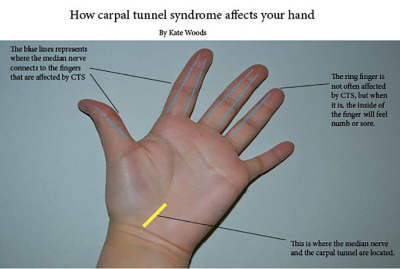STORY BY KATE WOODS
You’re sitting at your computer, playing a game or typing several essays due at the end of the weekend, when your hand and wrist suddenly feel painful.
That is just one cause and one symptom of carpal tunnel syndrome, which occurs when a nerve in the carpal tunnel, a long narrow passage that houses nerves and tendons from your arm to your hand, is irritated.
“It’s important to get it assessed, as carpal tunnel syndrome is one of the most misdiagnosed conditions,” said Justin Guy, a chiropractor at Mobility Plus Chiropractic on Argus Rd. in Oakville.
Symptoms of CTS are pain, tingling or numbness in the thumb and/or fingers. They may feel swollen and the pain can extend from your hand all the way up to your elbow. You may also experience weakness in the hand, mostly when doing activities that require the use of the thumb, such as pinching or grasping. CTS can be caused by a variety of things.

“It can be a combination of trauma to the hand or wrist, repetitive strain, posture and genetics,” said Guy.
“Genetics can determine the size of the carpal tunnel, which can make you more or less likely to develop the condition.”
Posture plays a key role in helping prevent CTS, as those who are at high risk of developing the condition are people who constantly use computers.
“You need to set up your desk properly and apply the use of ergonomics,” said Guy.
According to Guy’s blog on the Mobility Plus Chiropractic website, your computer should be setup at an arm’s length away for viewing distance, while the keyboard should be flat with the back tabs back in the keyboard. You should also keep your wrists in a flat, neutral position when using the mouse and keyboard and use palm supports.
“Take frequent breaks, every 20 to 25 minutes. Stretch your wrists and get the joints moving,” said Guy.
MORE RELATED TO THIS POST:
- Stress: a pain in the neck
- Only days remain to opt-out of SU healthcare plan
- Gamers earn cash through competitive video games
Richard Elder is a gamer and first-year student in Sheridan’s Internet Communications Technology program, and has lived with CTS in both hands for 12 years.
“I used to be on a Starcraft video game team,” said Elder.
“We had a doctor for the team and after getting sharp pains in my hands, I said something and they knew.”
Elder says it wasn’t just video games that made his condition worse, but also his work.
“I was a full-time chef in several different restaurants. Holding a knife every day, doing the same thing all day didn’t help with my condition.”
There are a few treatment options, including surgery. Elder has used several treatments.
“I used to wear a brace at night, but then I got use to sleeping with my wrist straight. I do wrist curls with free weights and I practice my flexibility to help with blood flow. It seems to be working.”
These treatments are recommended when diagnosed with CTS, and only when these treatments fail is surgery an option.
“The surgery has a 90 per cent success rate, but you are in a splint for up to two months and there is a 15 to 20 per cent recurrence rate,” said Guy.
Elder has been fortunate that his treatments are working and that he doesn’t have to do surgery.
“It’s never gotten to that point thankfully, because I don’t want to be out of commission for awhile for recovery.”
Both Guy and Elder recommend getting checked if you suspect you have CTS and to invest in ergonomic aids and furniture to help prevent and treat the condition.
“Ergonomics are a bit expensive,” said Elder. “But if you don’t take care of yourself now, later on you will feel it and it will hurt.”
For more information on ergonomics and CTS, check out Justin Guy’s blog at mobilitypluschiropractic.ca/blog
*Chiropractics and massage are covered under the SU healthcare plan

Comments
One response to “Cutting the nerve on carpal tunnel syndrome”
Hi Kate,
I just noticed that the above link to our blog is actually slightly different. Anyone can access the blog instead via http://www.mobilitypluschiropractic.com Good luck in the upcoming school year. 🙂
Justin